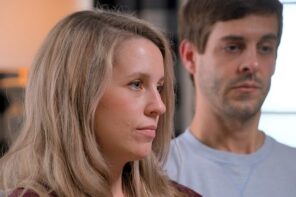After watching last night’s series premiere of Sister Wives, TLC’s new reality series about fundamentalist Mormon polygamist Kody Brown and his three—wait, now, four?!!—wives and thirteen—wait, now, sixteen?!!—children, what I find most remarkable is not the series itself but the rave reviews it’s getting from the critics.
The Vancouver Sun calls Sister Wives “a fascinating, surprising eyeopener.” (Never mind that British Columbia is home to one of the larger Mormon polygamous communities on the continent.) Us Magazine calls it “provocative” and “utterly fascinating” and gives it four stars. And over at the Los Angeles Times a reviewer crows: “I’ve seen the feminist revolution and it is . . . polygamy?” (Really? You’ve never seen women do collective childcare without being married to the same man?)
The show opens with shots of goatee-sporting blonde Kody Brown wearing his best pin-striped suit and sitting at the wheel of his white Lexus convertible, then cuts to shots of Kody Brown bopping around under a big white tent at a wedding reception, encircled by a passel of blonde wives and blonde kids, as Brown’s voice-over intones:
“My name is Kody Brown, and you’ve gotta meet my family. I like marriage. . . . And I’m a repeat offender.”
What follows is an hour of breakfast, burnt toast, yardwork, and family meetings. Arriving home from work, Brown, who has the vacant energy of a pep squad leader, greets each of his blonde wives with a passionless kiss, reserving his most serious affection for wife Christine’s pregnant belly. And a powerful dose of intrigue is provided by the appearance at episode’s end of a prospective fourth wife: this one, a brunette.
I finish the show finding myself just about as interested in the Brown family as I was in Jon and Kate Plus 8. (Same series producers, by the way.) Or the Duggars. Or any other reality-tv-icons of conspicuous reproduction.
Which is to say: I’m not interested at all.
Perhaps I’m not so impressed because as a Mormon woman, I’ve lived in close quarters with the idea of polygamy since I was a wee girl. True: the mainstream LDS Church has not officially sanctioned polygamy since 1890 or so, but even among mainstream Mormons, the question of polygamy in the afterlife remains theologically wide open, and to this day Mormon men may be “sealed” for eternity to more than one wife in an LDS temple.
As a writer, I’ve also been invited into the homes of polygamist families from two of the seven or eight major distinct fundamentalist Mormon communities—one Apostolic United Brethren family living in Utah Valley, and members of the Centennial Park group near Colorado City, Arizona.
I guess you might say I’m used to the idea that polygamists are humans.
An idea, apparently, that is supposed to be news to the show’s viewers and reviewers.
Polygamists! “Bright and generous!” blares the LA Times. “Unexpectedly tight knit and loving!” brag the show’s producers. Wow! They share stuff! The older kids scramble eggs for the younger ones! Some wives work outside the home, while other wives watch the kids! They don’t have weird sex! They have granite kitchen countertops like we do! The parents want their kids to grow up and be happy, productive members of society! And they all have a great “work ethic!” Eye-opening! Unbelievable!
Yawn.
Instead, I find myself asking the following questions:
Why am I being taken on a tour of computer-generated graphic rendition of the Brown’s three-level suburban home?
Why am I peeking into these windowless bedrooms at middle-aged, middle-class blondes in fuzzy slippers and sweats?
Why am I spending an hour of my life watching a middle-aged advertising salesman in suburban Utah standing there in the predawn hours in his sweats explaining where he keeps his clothes?
And perhaps because I’m tuned in on assignment as a religion columnist I’m disappointed by the near absence of religion in the episode. Early in the show, Brown tries to set the record straight: mainstream LDS folks don’t practice polygamy, he says. He also claims that mainstream LDS Mormons and fundamentalist Mormons have about as much in common as Catholics and Protestants—a statement which is, well, untrue and screens out a whole world of social history and nuance. But I know, I know—it’s only TLC.
Most telling, though, is the fact that Kody Brown has been carefully coached to call polygamy “the lifestyle” rather than “the principle,” the latter being the economic phrase commonly used by fundamentalist Mormons to describe both the practice of polygamy and its theological underpinnings. All throughout Sister Wives it’s “the lifestyle,” “lifestyle,” “lifestyle”: only once does Brown slip and call it “the principle.”
Take the theology out of polygamy, and what you have is a rather uptight and domesticated form of man-centric polyamory. It’s Father Knows Best on steroids and with a Costco executive-level membership.
Which is about as interesting to me as Kate Gosselin’s latest makeover.
But the b-o-r-i-n-g world of Kody Brown and family may in fact be a tremendous blessing to the broader community of 40,000 plus Mormon fundamentalist polygamists, most of whom have been struggling to get out from under PR havoc wreaked by the exploits of monomaniacal FLDS leader Warren Jeffs and his now infamous exploits in underage arranged marriage and wardrobe control. (Jeffs was the leader of the Fundamentalist Church of Jesus Christ of Latter-day Saints; the Brown family belongs to the Apostolic United Brethren, a very different Mormon fundamentalist sect.)
“We’re not the polygamists you think you know,” Kody Brown tells the camera as he sits at the wheel of his white Lexus.
Which is to say “we’re not child-marriage-arranging-lost-boy-exiling-prairie-dress-wearing people-who-allegedly-deserve-to have-their-children-taken-from-them-by-the-state-of-Texas.”
That’s what Sister Wives and its ad-salesman-protagonist are trying to sell: utter normalcy.




